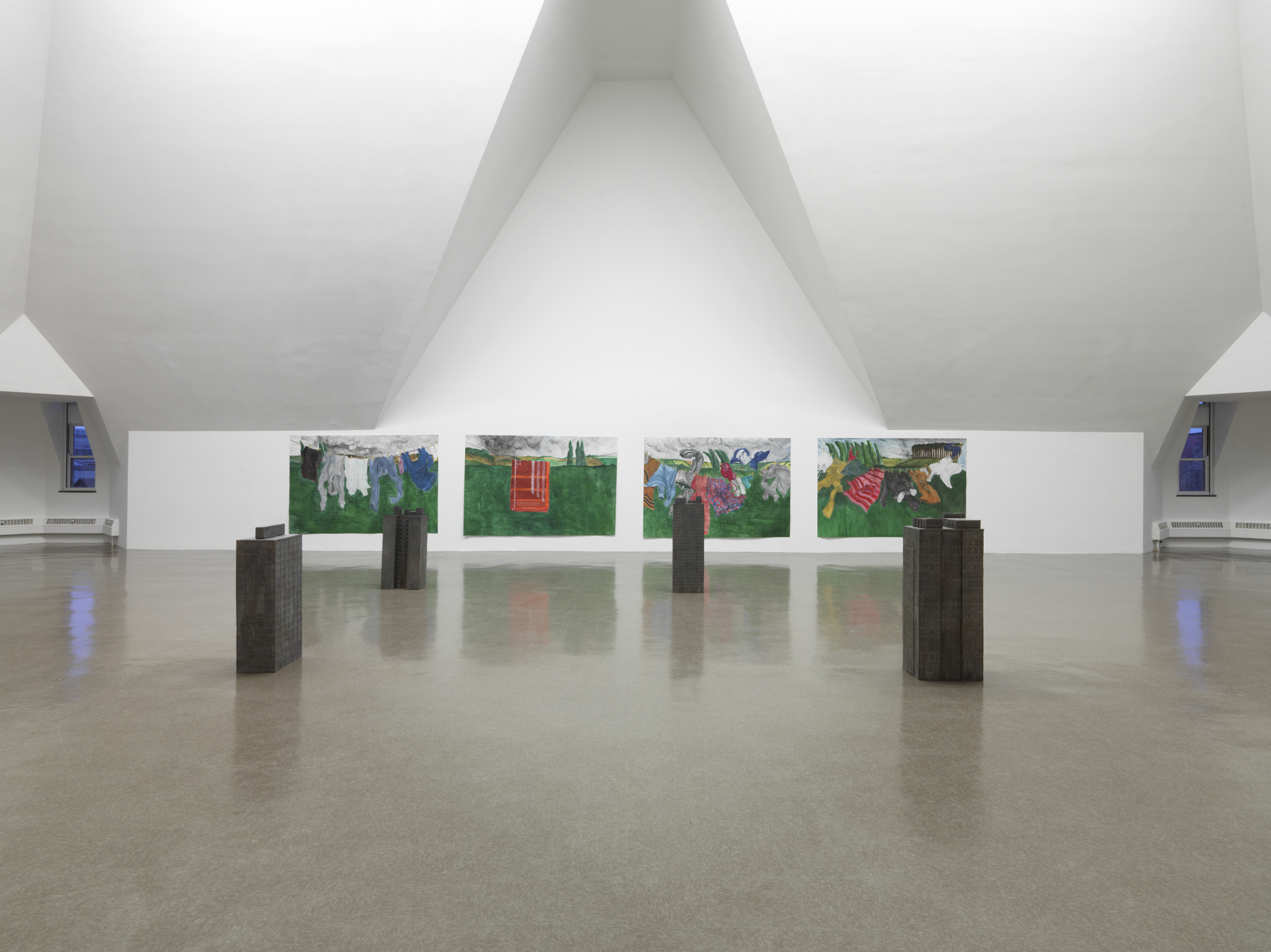Peter Wächtler’s Secrets of A Trumpet is on display at the Renaissance Society, mostly. The exhibition’s lone outlier—a bronze statue of an otter in a baseball uniform—stands a few hundred feet outside on the University of Chicago quadrangle. The oddly charming piece is a nice bit of publicity for the rest of the Brussels-based German artist’s work, commissioned specifically for the Renaissance Society. But after viewing the rest of the exhibition, one can’t help but wonder if its displacement carries some higher significance. One leaves Wächtler’s exhibition in a state of giddy confusion; it is the kind of art that makes you think deeply about art.
Before entering the stark white, high-ceilinged exhibition space, one encounters a prose poem of sorts, the text of an unfocused, colloquial monologue mounted on two wall panels. Its speaker, an unnamed middle-aged man, examines “what makes a good farmer,” the importance of planning, love, and his many frustrations, without reaching much of a conclusion. One enters the main body of the exhibition with a confusion that is never fully resolved.
The exhibition’s individual components are wildly divergent, lacking any obvious commonalities in either style or subject. The tone is set with Wächtler’s “Teddy Boy” series, the first cluster, which consists of four rectangular wooden boxes against a wall, each depicting the life of a big-haired, gaudily attired man from the titular British subculture on three sides. The scenes are drawn in a deliberately amateurish style; colors are sloppy, and pencil shows through under the paint.
Many of the scenes are abjectly ridiculous, most notably “Meeting the Pimps,” in which the protagonist is threatened by men with sinister expressions and identical towers of hair. Yet other scenes are peculiarly touching, like “A Winter’s Day,” in which Teddy Boy lies in bed with a woman, looking content. Moments of sensitivity and farce bleed into each other; though the pimps are almost laughably absurd, their presence cannot trivialize the simple, human fear on our hero’s face. Even in “Feeling Sick,” Teddy Boy’s ridiculous hair competes for attention with the dignity of his suffering.
In the center of the exhibition are four monolithic sculptures of mass housing units, standing roughly five feet tall. At a distance, these appear starkly black and foreboding, but upon a closer examination, they appear less artificial—as distinctly human spaces, as stacks of homes. Their metal is a warm, deep bronze color, and there are visible flaws in its casting: various bumps, divots, and ridges. Once known up close in this manner, one feels a peculiar sense of intimacy, as if each window stands in for some tiny, unknowable life.
Most impressive, however, is Wächtler’s “Laundry” series. Four enormous watercolors depict clothes hanging on clotheslines, flailing in the wind against a simple pastoral background. Stylistically, the “Laundry” series is a refinement of the “Teddy Boy” series; while Teddy Boy’s spontaneous messiness is all but absent, and the clothing in “Laundry” is realized in much more intricate detail, the two works are similar insofar as they bear some mark of their own composition. The broad brushstrokes that make up the grass in “Laundry,” for example, are immediately apparent as brushstrokes; there is no question of pure realism here.
Wächtler embraces a sort of compositional self-consciousness; his viewer can at once appreciate the process of creation and the creation itself. This is most visible in one shirt in particular, a green and white button-down. The shirt is composed of just pencil and crayon, more minimal even than the rest of the composition, which is rendered in watercolor.The crude, material simplicity of Wächtler’s medium demands as much attention as the elegant complexity with which the shirt is drawn, down to the last button. It is at once a preliminary sketch and the full realization of the sketch, both physical material and ineffable idea.
Each project is unmistakably distinct, and yet Secrets of A Trumpet remains unified in this sense of ambivalence, in its refusal to be simplified. There is a deep sense of freedom to these compositions, and Wächtler can get away with almost unthinkable artistic risks. One might easily complain that the baseball-playing otter is kitschy, that “Laundry” is mundane, that “Teddy Boy” is overly sentimental. While such criticism is far from groundless, it would miss the point. Beauty is all the more intense when it arrives unexpectedly, in the guise of the unlovely. It is for such moments of bewildering surprise that Secrets of A Trumpet is so uniquely compelling.
Secrets of a Trumpet, the Renaissance Society, 5811 South Ellis Avenue, 4th floor. Through April 3. Guided walkthrough on February 17, 6pm. Tuesday–Friday, 10am–5pm; Saturday–Sunday, noon–5pm. Free. (773)-702-8670. renaissancesociety.org



